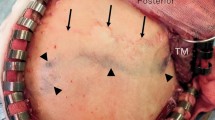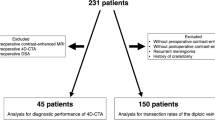Abstract
Purpose
The anatomy and distribution of the diploic veins (DVs) of the cranial base have not been fully documented. The aim of this study was to characterize these veins using contrast magnetic resonance imaging (MRI).
Methods
In total, 95 patients underwent thin-sliced, contrast MRI. Coronal and sagittal images were used for the analysis. The cranial base was divided into the anterior, middle, and posterior bases. Then, each base was further subdivided into three equal parts in the anteroposterior and lateromedial directions. The anteroposterior parts were evaluated on coronal images, while the lateromedial parts were evaluated on sagittal images.
Results
The DVs were identified over the entire cranial base. However, they were more frequent in the posterior-third of the lateral-third region of the anterior, middle-third of the lateral and middle-third regions of the middle, and middle-third region of the posterior cranial base, and sparse in the posterior and medial-third regions of the middle cranial base. The DVs showed marked morphological variability. For instance, the DVs of the pterional area were generally well defined, as pivotal channels connecting the lateral parts of the anterior and middle cranial base, but were highly varied in appearance.
Conclusions
The DVs of the cranial base are distinct structures characterized by morphological variability and topographical predilection. Contrast MRI is useful for delineating these veins.












Similar content being viewed by others
References
Altafulla JJ, Rai R, Shrager S, Voin V, Iwanaga J, Litvack Z, Loukas M, Tubbs RF (2019) Transclival venous circulation: anatomic study. World Neurosurg 121:e136–e139
Furuya Y, Edwards MS, Alpers CE, Tress BM, Ousterhout DK, Norman (1984) Computerized tomography of cranial sutures. Part 1: comparison of suture anatomy in children and adults. J Neurosurg 61:53–58
García-González U, Cavalcanti DD, Agrawal A, Gonzalez LF, Wallace RC, Spetzler RF, Preul MC (2009) The diploic venous system: surgical anatomy and neurosurgical implications. Neurosurg Focus 27:E2
Hershkovitz I, Greenwald C, Rothschild BM, Latimer B, Dutour O, Jellema M, Wish-Baratz S, Pap I, Leonetti G (1999) The elusive diploic veins: anthropological and anatomical perspective. Am J Phys Anthropol 108:345–358
Ishii R, Ueki K, Ito J (1976) Traumatic fistula between a lacerated middle meningeal artery and a diploic vein; case report. J Neurosurg 44:241–244
Jivraj K, Bhargava R, Aronyk K, Quateen A, Walji A (2009) Diploic venous anatomy studied in vivo MRL. Clin Anat 22:296–301
Kunz AR, Iliadis C (2007) Hominid evolution of the arteriovenous system through the cranial base and its relevance for craniosynostosis. Childs Nerv Syst 23:1367–1377
Mizutani K, Toda M, Kurasawa J, Akiyama T, Fujiwara H, Jinzaki M, Yoshida K (2017) Analysis of the venous channel within the clivus using multidetector computed tomography digital subtraction venography. Neuroradiology 59:213–219
Mizutani K, Akiyama T, Yoshida K, Toda (2018) Skull base venous anatomy associated with endoscopic skull base neurosurgery: a literature review. World Neurosurg 120:405–414
Nerva JD, Hallam DK, Ghodke BV (2014) Percutaneous transfacial direct embolization of an intraosseous dural arteriovenous fistula. Neurosurgery E4:178–182
Rangel de Lázaro G, de la Guétara JM, Píšová H, Lorenzo C, Bruner E (2016) Diploic vessels and computed tomography: segmentation and comparison in modern humans and fossil hominids. Am J Phys Anthropol 159:313–324
Thewissen JG (1989) Mammalian frontal diploic vein and the human foramen caecum. Anat Rec 223:242–244
Toriumi H, Shimizu T, Shibata M, Unekawa M, Tomita Y, Tomita M, Suzuki N (2011) Developmental and circulatory profile of the diploic veins. Microvasc Res 81:97–102
Tsutsumi S, Nakamura M, Tabuchi T, Yasumoto Y, Ito M (2013) Calvarial diploic venous channels: an anatomic study using magnetic resonance imaging. Surg Radiol Anat 35:935–941
Tsutsumi S, Ogino I, Miyajima M, Ito M, Arai H, Yasumoto Y (2015) Cerebrospinal fluid drainage through the diploic and spinal epidural veins. J Anat 227:297–301
Tubbs RS, Watanabe K, Loukas M, Cohen-Gadol AA (2014) Anatomy of the inferior petro-occipital vein and its relation to the base of the skull: application to surgical and endovascular procedures of the skull base. Clin Anat 27:698–701
Funding
No funding was received for this study.
Author information
Authors and Affiliations
Contributions
ST conceived the study. HO and YY collected the imaging data. ST and HI analyzed the imaging data. ST wrote the manuscript.
Corresponding author
Ethics declarations
Conflict of interest
The authors have no conflict of interest to declare regarding the materials or methods used in this study or the findings presented in this paper.
Ethical approval
All procedures performed in the studies involving human participants were in accordance with the ethical standards of the institutional and/or national research committee and with the 1964 Helsinki Declaration and its later amendments or comparable ethical standards.
Informed consent
Informed consent was obtained from all involved participants included in the study.
Additional information
Publisher's Note
Springer Nature remains neutral with regard to jurisdictional claims in published maps and institutional affiliations.
Rights and permissions
About this article
Cite this article
Tsutsumi, S., Ono, H., Ishii, H. et al. Diploic veins of the cranial base: an anatomical study using magnetic resonance imaging. Surg Radiol Anat 41, 1029–1036 (2019). https://doi.org/10.1007/s00276-019-02283-y
Received:
Accepted:
Published:
Issue Date:
DOI: https://doi.org/10.1007/s00276-019-02283-y




